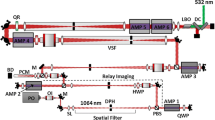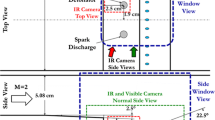Abstract
Experiments are conducted on a planar ramp in high-enthalpy flow, with gaseous hydrogen injected through a porthole at the ramp surface. The ramp is covered in a thin layer of temperature-sensitive luminescent paint, originally intended to allow surface heat-flux measurements; however, anomalous transient features are identified in high-speed recorded images of the paint emission, which are postulated as originating from excitation by OH* chemiluminescence produced during hydrogen combustion. By assuming the OH*-induced emission to occur on much shorter timescales than surface temperature changes, it is possible to extract this pseudo-OH* signal, allowing time-resolved combustion features to be investigated. Two cases are examined, the first exhibiting marginal combustion and the second with more robust ignition. For the first, the weak OH* excitation allows concurrent temperature and heat-flux distributions to be derived. In both cases, the time-averaged combustion distribution shows intense ignition in the immediate vicinity of the injection hole, with extended fingers of weaker combustion extending downstream; the latter are assumed to be associated with the main counter-rotating vortex pair produced by the injection. By examining shorter timescales, however, it is revealed that these combustion fingers are not steady features but rather the time-integrated result of more localized ignition streaks convecting downstream. Overall, the presence of combustion is associated with higher surface heat fluxes. The pseudo-OH* visualization method is a possible alternative to conventional OH* chemiluminescence for wall-bounded combusting flows, allowing a conventional visible-wavelength camera to be employed in place of a UV-sensitive imaging system.
Graphic Abstract













Similar content being viewed by others
References
Ames Research Staff (1953) Equations, tables, and charts for compressible flow. NACA Report 1135
Colket MB, Spadaccini LJ (2001) Scramjet fuels autoignition study. J Prop Power 17(2):315–323
Cook W, Felderman E (1966) Reduction of data from thin-film heat-transfer gages: a concise numerical technique. AIAA J 4(3):561–562
De Leo M, Saveliev A, Kennedy LA, Zelepouga SA (2007) OH and CH chemiluminescence in opposed flow methane oxy-flames. Comb Flame 149:435–447
Gamba M, Mungal MG (2015) Ignition, flame structure and near-wall burning in transverse hydrogen jets in supersonic crossflow. J Fluid Mech 780:226–273
Gerhold T, Friedrich O, Evans J, Galle M (1997) Calculation of complex three-dimensional configurations employing the DLR TAU-code. AIAA Paper No. 97-0167
Gruber MR, Nejad AS, Chen TH, Dutton JC (1995) Mixing and penetration studies of sonic jets in a mach 2 freestream. J Prop Power 11(2):264–273
Hannemann K (2003) High enthalpy flows in the HEG shock tunnel: Experiment and numerical rebuilding. In: 41st AIAA Aerospace Sciences Meeting and Exhibit, Reno, Nevada
Hardalupas Y, Orain M (2007) Local measurements of the time-dependent heat release rate and equivalence ratio using chemiluminescent emission from a flame. Comb Flame 139:188–207
Kawai S, Lele SK (2010) Large-eddy simulation of jet mixing in supersonic crossflows. AIAA J 48(9):2063–2083
Krek RM, Jacobs P (1993) STN, shock tube and nozzle calculations for equilibrium air. Department of Mechanical Engineering Report 2/93, The University of Queensland
Laurence S, Lieber D, Schramm JM, Hannemann K, Larsson J (2015) Incipient thermal choking and stable shock-train formation in the heat-release region of a scramjet combustor. Part I: Shock-tunnel experiments. Comb Flame 162(4):921–931
Laurence SJ, Karl S, Hannemann K (2013a) Experimental and numerical investigation of the HyShot II flight experiment. In: Proceedings of the 29th International Symposium on Shock Waves (ISSW 29), Madison, WI, USA
Laurence SJ, Karl S, Schramm JM, Hannemann K (2013b) Transient fluid-combustion phenomena in a model scramjet. J Fluid Mech 722:85–120
Laurence SJ, Ozawa H, Schramm JM, Hannemann K (2019) Heat-flux measurements on a hypersonic inlet ramp using fast-response temperature sensitive paint. Exp Fluids 60:70
Liu Q, Baccarella D, McGann B, Lee T (2019) Cavity-enhanced combustion stability in an axisymmetric scramjet model. AIAA J 57(9):3898–3909
Mahesh K (2013) The interaction of jets with crossflow. Ann Rev Fluid Mech 45(1):379–407
Micka DJ, Torrez SM, Driscoll JF (2009) Heat release distribution in a dual-mode scramjet combustor - measurements and modeling. AIAA Paper 2009-7362
Najm HB, Paul PH, Mueller CJ, Wyckoff PS (1998) On the adequacy of certain experimental observables as measurements of flame burning rate. Comb Flame 113:312–332
Ozawa H, Laurence SJ, Schramm JM, Wagner A, Hannemann K (2015) Fast-response temperature-sensitive-paint measurements on a hypersonic transition cone. Exp Fluids 56(1):1853
Schefer R, Kulatilaka W, Patterson B, Settersten T (2009) Visible emission of hydrogen flames. Comb Flame 156:1234–1241
Snavely BB, Peterson OG, Reithel RF (1967) Blue laser emission from a flashlamp-excited organic dye solution. Appl Phys Lett 11(9):275–276
Sun M, Hu Z (2018) Formation of surface trailing counter-rotating vortex pairs downstream of a sonic jet in a supersonic crossflow. J Fluid Mech 850:551–583
Acknowledgements
The authors gratefully acknowledge the HEG technical staff, particularly Ingo Schwendtke and Bartek Klaskala, for support and assistance during this experimental campaign.
Author information
Authors and Affiliations
Corresponding author
Additional information
Publisher's Note
Springer Nature remains neutral with regard to jurisdictional claims in published maps and institutional affiliations.
Rights and permissions
About this article
Cite this article
Laurence, S.J., Ozawa, H., Martinez Schramm, J. et al. Combined combustion and heat-flux measurements on a supersonic jet-in-crossflow configuration using luminescent paint. Exp Fluids 62, 154 (2021). https://doi.org/10.1007/s00348-021-03246-z
Received:
Revised:
Accepted:
Published:
DOI: https://doi.org/10.1007/s00348-021-03246-z




